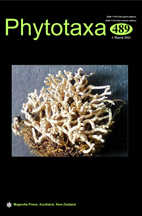Abstract
The taxonomic status of species assigned to the marine red algal genus Osmundea from Pacific North America has not been critically studied. We analyzed the complete organellar genomes of an isotype specimen of O. sinicola and conducted a genetic comparison of rbcL and COI-5P markers based on 15 specimens of Laurencia scrippsensis, O. crispa, and O. sinicola collected from California, the Gulf of California, and Pacific Baja California, including their type specimens. The mitogenome of O. sinicola was 25,021 bp in length and contained 44 genes, and the plastid genome was 171,419 bp with 225 genes. Both genomes show a high level of gene synteny with previously published organellar chromosomes from the Rhodomelaceae. Phylogenetic analysis of the rbcL and COI-5P genes identified two distinct clades, one containing the isotype of O. sinicola, and the other included the isotype of O. crispa and holotype of Laurencia scrippsensis. These data show that L. scrippsensis is a heterotypic synonym of O. crispa, rather than of O. sinicola. They support the recognition of two species, O. crispa from Monterey, California to Baja California Sur, and O. sinicola from Baja California Sur to the Gulf of California. California specimens identified as O. sinicola are misidentified O. crispa. Reports of O. sinicola from outside this range based on morpho-anatomy require confirmation by DNA sequencing. These genetic results highlight the need further analyses of type material from the Rhodomelaceae.

